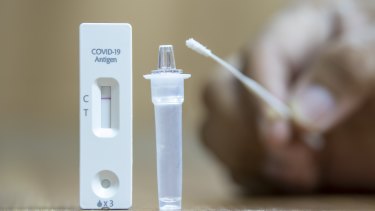What can we do as individuals to combat the winter COVID-19 wave? In the third instalment of a special series, The Age’s health team asks experts for the best advice on testing.
RATs, PCRs … the once-unknown abbreviations that are now part of our common parlance will continue to play an important role as new COVID-19 subvariants whip through our homes, schools and hospitals.
Rapid-antigen tests are less reliable than PCRs.Credit:Getty Images
Standing in a queue to get a PCR test is less common given the rise of rapid-antigen tests to help monitor, isolate and report coronavirus infections.
RATs are an excellent screening tool for the virus, but they are not foolproof.
To be approved by the Therapeutic Goods Administration (TGA), the self-test kits must have 80 per cent clinical sensitivity, which means one in five test results could be false (false negatives are more common). If the tester is asymptomatic, this decreases to 40 per cent to 60 per cent.
It’s a vulnerability people have learnt to exploit. There have been reports of schoolchildren in the UK skipping class after pouring an acidic substance such as orange juice on the test to turn up a fake positive.
Some RATs are better than others and the TGA lists the different approved tests and their clinical effectiveness on its website.
At the moment, you can get 10 free RATs if you are a concession card holder, but that program runs out at the end of the month unless Prime Minister Anthony Albanese decides to extend it.
If you’re suspicious about a negative RAT result, you have the option of doing more tests, staggered over a few days as you start to shed more virus, but experts say if you’ve got symptoms or think you’ve caught COVID-19, a PCR test is best.
This is especially important if you want access to antiviral drugs, which are only effective when taken within five days of symptoms emerging.
But under Victorian government changes to PCR testing eligibility, only clinically vulnerable people or those in at-risk groups can access them, in a bid to ensure appropriate treatment is provided.
This includes people aged 65 and over, Aboriginal and Torres Strait Islanders aged 50 and over, people with compromised immunity and people with a disability.
PCR testing sites are still open across the state, while the “Call to Test Program” is available for people who are eligible for a PCR test at home.
As well as being more accurate, PCR tests also test for flu and respiratory syncytial virus. They give a firm diagnosis and health authorities a clearer picture of prevailing infections in the community.
Queensland University infectious diseases expert Paul Griffin said it was critical that people continued to test. But he added it was important that health authorities get the rules right on isolation requirements to avoid a situation where infected people avoided testing so they did not have to isolate for seven days.
“There are people who don’t want to isolate for seven days who are probably not testing or reporting on these grounds,” Griffin said.
“It’s something that needs to be looked at; people can definitely be infectious after seven days. But the flipside is that if that interval was shortened, maybe more people would actually tell us and isolate for at least a shorter period, which is better than not isolating at all.”
Griffith University infectious diseases expert Nigel McMillan said Australians were generally good at self-reporting their positive RAT results compared with people in other countries. Victorians are legally required to report positive RAT results to the Health Department.
“One of the reasons New Zealand and Australia have such high [known] infection rates right now is that we obviously report our tests judiciously. We’re very good at it,” McMillan said.
The Morning Edition newsletter is our guide to the day’s most important and interesting stories, analysis and insights. Sign up here.
Most Viewed in National
From our partners
Source: Read Full Article

